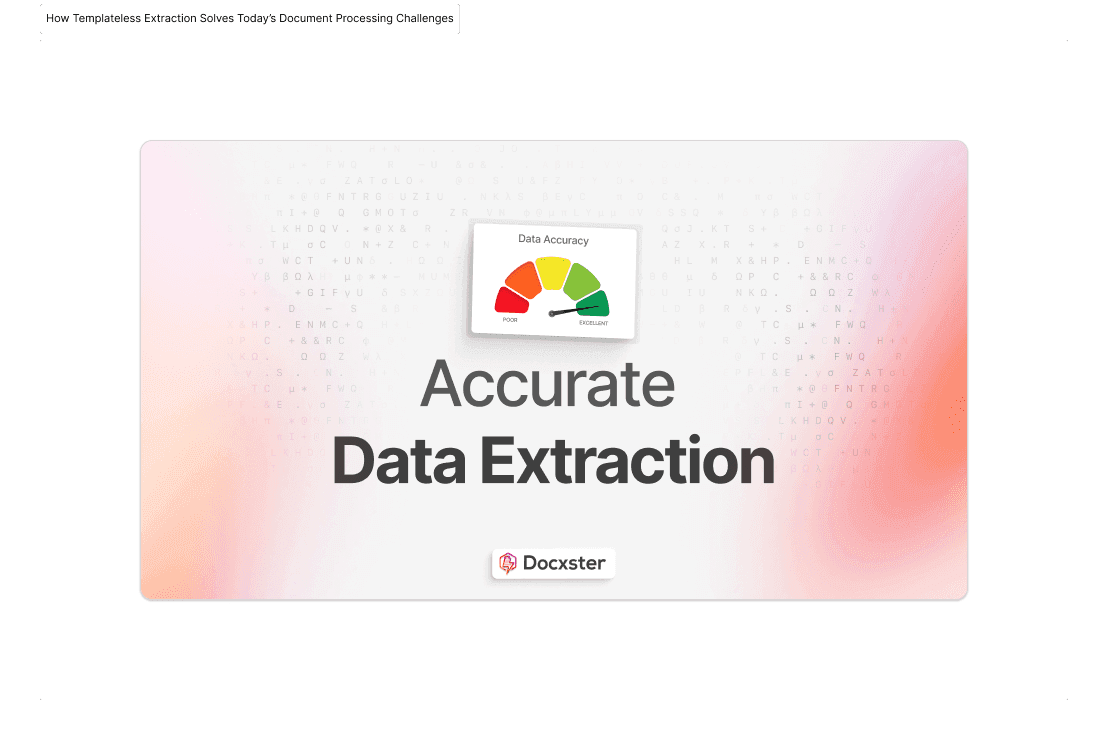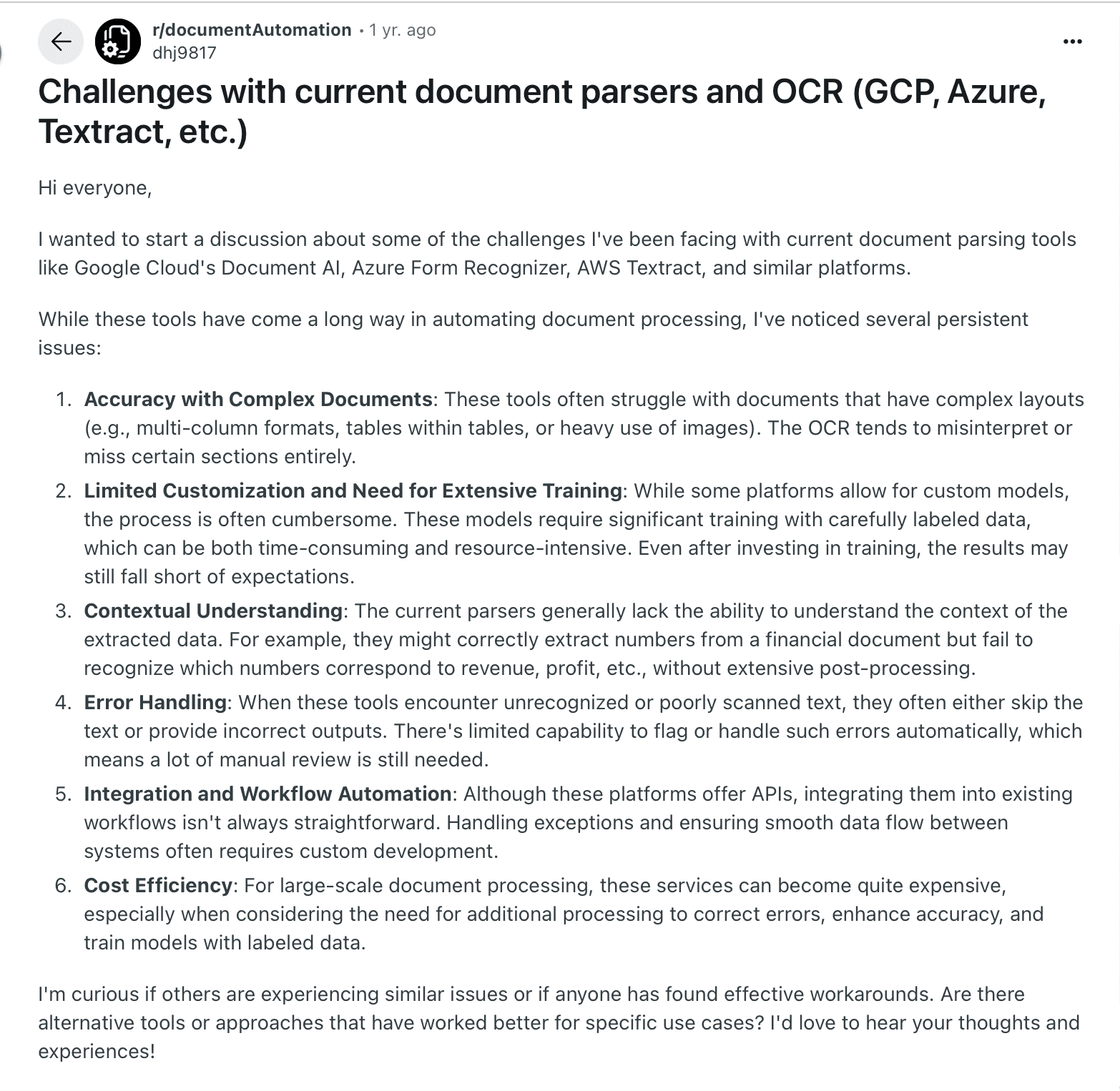
You’re trying to process a new invoice, but the system doesn’t recognize it. The template doesn’t match. The workflow stalls. What should be routine now demands manual work.
I hear this often from finance and operations leaders. The problem isn’t a lack of automation. It’s that most tools still depend on templates, and those templates break the moment formats change.
When that happens, the impact is clear: invoices are delayed, purchase orders stall, and compliance documents start piling up.
This guide shows why templates no longer work, and how templateless extraction helps manufacturing and logistics teams scale.
What is templateless extraction?
Templateless extraction is the ability to capture and process information from any document format without creating predefined templates. It uses AI to recognize patterns, interpret content, and adapt instantly to new layouts, even when data is unstructured or presented in different ways.
If you’re managing a high document volume every month, this means you can process documents without worrying about creating new templates for new document formats. As a result, you don’t have to deal with unnecessary delays in the long run.
Information moves from document to workflow immediately, so teams can focus on resolving exceptions, meeting deadlines, and keeping operations running smoothly.
Here’s a glance at the difference between template based extraction and templateless:
Why template-based extraction doesn’t work anymore
Before I go into how templateless extraction works, let’s see why template-based extraction is not the right move for businesses anymore:
Hardcoding templates slows you down and doesn't scale
You’ve probably been in the industry long enough to see how hardcoding was the norm. For many teams, the mix was predictable, so rule sets on top of OCR did the job with reliable extraction and low variance. That was the norm because it was clear, testable, and easy to govern.
As volumes and partners grew, the picture changed. The more document types you add, the harder it gets to maintain hardcoded rules. In manufacturing and logistics, where invoices, POs, delivery notes, and customs forms vary by vendor and region, the maintenance load compounds.
And what happens then? Well, time that should go to exceptions and approvals gets pulled into template adjustment.
Uber’s invoice processing relied on rule-heavy workflows that were difficult to scale and limited efficiency. That is when they decided to move to a Gen-AI powered approach. This approach for invoices helped Uber double throughput, cut handling time by about 70 percent, and deliver 25 to 30 percent cost savings, while improving data accuracy using AI models like GPT‑4 and more.
Companies like Uber are making this shift because hardcoded templates slow teams down and do not scale when document variety is the default.
Template-based tools break with complex layouts and vendor document changes
Template-based tools expect documents to follow fixed, predictable layouts. But in reality, in finance or manufacturing, layouts vary by vendor, change often, and include tables or notes templates can’t handle.
“A significant percentage of documents don’t fit standard templates. Forms with handwritten notes, unique customer requests, or industry-specific compliance documents often require manual processing. A rough estimate from speaking with business leaders suggests that anywhere from 20–40% of documents fall outside standard formats.”
When as much as 20–40% of your documents cannot run through the standard template, the system you set up stops delivering consistent results.
Instead of just passing through, your documents pile up and your team has to come in and go back to manual data entry processes. So, instead of seeing the “gains” that automation promised, they’re back to square one.
Template-based tools can’t adapt to seasonal spikes
Templates use pre-defined rules. Teams must test, validate, and deploy them before processing new documents. When demand suddenly surges, there is no quick way to adjust those rules without pulling in IT, making changes, and running the whole testing cycle again.
You have probably seen this play out. I’ve too. I’ve been with teams sized for regular volumes when a seasonal rush, a new vendor, or an unexpected backlog hit. What was once a manageable pace quickly tipped into something harder to control, and the tools in place simply couldn’t adjust fast enough.
The team size you have for regular volumes can’t handle a sudden spike—and it doesn’t make sense to hire people just for one month. The costs add up and hiring is a whole other challenge of its own.
Without automation that adapts in real time, the extra work lands on the same shoulders, and even the most efficient process starts to fray.
Cost-effective AI means templates are now obsolete
I came across a thread on Reddit that summed up one of the biggest challenges with document processing:
That used to be the reality. The good news is, the cost of extraction has dropped significantly, even in developing countries. I’ve seen AI-powered solutions become affordable enough that teams no longer have to weigh the price of automation against the cost of doing it manually.
This changes the equation completely. Template-less, AI-powered extraction is now not only faster and more accurate, but also cost-effective.
When you don't have to worry about the steep cost of extraction anymore, it doesn't make sense to invest in template-based tools anymore. The lower costs and higher flexibility brings your organization into the future.
How templateless extraction helps manufacturing and logistics companies
I’ve been talking to finance and manufacturing leaders over the past few months. Their top challenge is coping with changing document volumes.
At Docxster, that’s why we built templateless extraction into our platform. Here’s how it helps:
Reduces the need for IT intervention in daily operations
I’ve seen how frustrating it can be when your IT team has to step in for something as routine as processing a new vendor’s invoice.
In a template-based setup, any change to the format means someone needs to create or modify a template, write the code, and test it before the process can run again. If that vendor later upgrades their software, the format changes and you’re back to the same cycle.
This is where templateless extraction helps. It adjusts to new formats automatically, keeping your operations running without waiting for IT to reconfigure templates. Onboarding vendors is quicker, workflows stay uninterrupted, and your team can focus on approvals, payments, and production schedules.
That’s the kind of continuity most leaders expect when they first invest in digitization, and it’s exactly what templateless extraction delivers.
Reduces the total cost of ownership (TCO)
Variability in document formats doesn’t just slow things down—it quietly eats into your budget. Every time a new layout arrives, you’re effectively paying for time spent updating templates, re-testing tools, or even hiring data science help to fix the gaps.
I’ve heard it put bluntly before: “A normal IT team can’t handle that… we used to need data scientists for this—and they cost a lot.”
That cost disparity matters. Data scientists in India, for example, earn around ₹11 lakh per year, with top professionals making upwards of ₹21 lakh annually, while in the U.S., the average data scientist salary can approach $156,000 annually.
Now, think about what happens when you remove that need. Such drastic drops in manual effort mean lower staffing costs and fewer errors to reconcile.
Faster time to value
Traditional document extraction projects can drag on for weeks, sometimes months, because teams spend so much time creating and testing templates. Every new layout adds more rework before the system is even usable. With templateless extraction, that delay disappears.
Earlier, models had to be trained for three to four months before teams could see results. Now it’s just a simple workflow you need to build, which makes implementation much faster and far less resource-intensive.
At Docxster, we’ve seen how modern AI no longer runs OCR, layout, and interpretation as separate steps.
Previously, OCR would read documents line by line. Then layout would break the page into blocks so OCR could work section by section. Finally, intelligence would interpret what those blocks meant before giving you the output.
Now, all of that happens in one step—the extraction step. And because intelligence is built in, the platform not only pulls the data but also understands the context behind it.
Want to understand the difference better? Here’s a table comparing both:
Future-proofs your document stack
What I’ve seen with templateless extraction is that once it’s in place, your document stack doesn’t need to be rebuilt every time something changes. The system is AI-native, which means it can take on new formats, additional languages, and more complexity without extra engineering effort.
For manufacturing and logistics leaders, I’ve seen this matter most when companies expand into new markets, try to digitize years of old paperwork, or connect with global systems. With templates, that usually means redesigning the stack again and again.
With templateless extraction, the stack you build once is ready to handle those changes without extra effort.
How Docxster helps with templateless extraction
At Docxster, we’ve worked to make templateless extraction easy for finance, manufacturing, and logistics teams.
Here’s how it works in high-volume environments where accuracy, speed, and flexibility are critical:
- Document ingestion: You upload the invoice (or purchase order, bill of lading, even a handwritten note). Any format works.
- OCR + Layout detection + AI in one pass: The system reads, structures, and interprets the invoice in a single step. Side-by-side fields and complex tables stay intact, so nothing gets lost.
- Automated field mapping and validation: Docxster automatically picks up fields like PO number, tax, and totals, then validates them against your ERP. A human only steps in if confidence drops.
- Workflow automation: Once validated, the invoice data moves directly into your accounting system for approval and payment.
Making the shift from template-based to template-less document extraction
For years, template-based extraction was the standard. It worked when document formats stayed predictable, but that’s no longer the case. Vendors use different platforms, rules keep shifting, and formats change faster than templates can keep up.
That doesn’t mean your business should carry the cost of outdated systems. Templateless extraction keeps processes running smoothly, no matter the document type or format.
We built Docxster on this principle. Our goal is to make digital transformation practical and achievable, one workflow at a time.
Ready to see templateless extraction action? Book a demo with us today.
Get Document Intelligence in Your Inbox.
Actionable tips, automation trends, and exclusive product updates.

